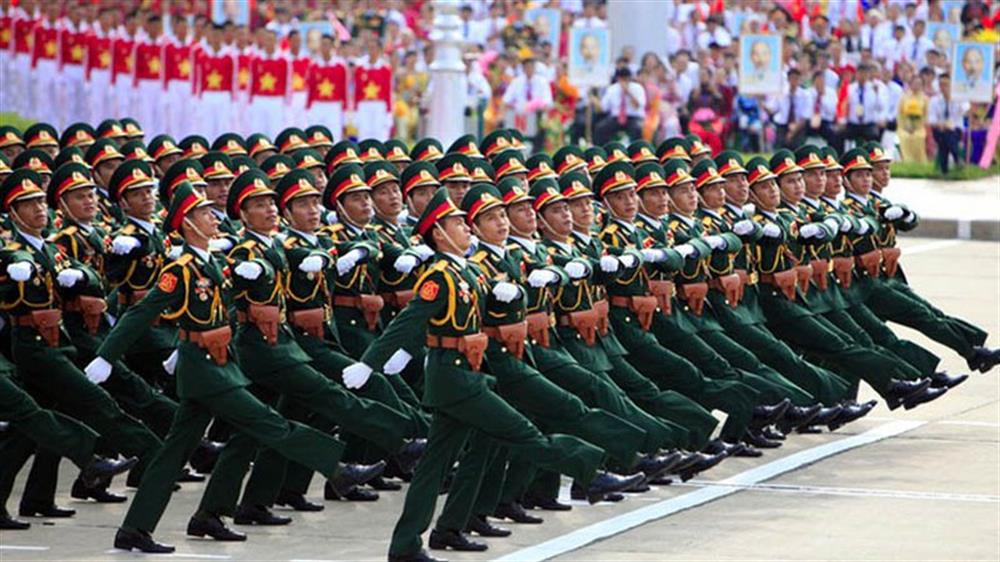 |
I. PEOPLE'S ARMY OF VIETNAM - 80 YEARS OF BUILDING, FIGHTING, VICTORY AND GROWTH
1. The Vietnam Propaganda Liberation Army - the predecessor of the Vietnam People's Army - was born, won the first two battles, and together with the people carried out a General Uprising to seize power (1944 - 1945).
Right from its inception (February 3, 1930), in its first political platform, our Party affirmed that the path to struggle for class liberation and national liberation was to use revolutionary violence to seize power and required “Organizing a worker-peasant army”[1] to serve as the core for the entire people to carry out the revolutionary struggle. The Party’s political platform (October 1930) determined the essential task of the bourgeois democratic revolution, which clearly stated: “Establishing a worker-peasant army”[2].
In the revolutionary movement of 1930 - 1931, the peak was the Nghe - Tinh Soviet, from the uprising force of workers and peasants, the Workers and Peasants Self-Defense Team (Red Self-Defense) was born. That was the first premise of the Vietnamese revolutionary armed forces. Following that, a series of armed organizations were established one after another such as: Bac Son Guerrilla Team (1940), Guerrilla Teams in the South (1940), National Salvation Army (1941)...
On December 22, 1944, in the forest between Hoang Hoa Tham and Tran Hung Dao communes in Nguyen Binh district, Cao Bang province (now Na Sang hamlet, Tam Kim commune, Nguyen Binh district, Cao Bang province), the Vietnam Propaganda Liberation Army Team - the predecessor of the Vietnam People's Army was established according to the Directive of Leader Ho Chi Minh. In the Directive, he clearly stated: "The name VIETNAM PROPAGANDA LIBERATION ARMY TEAM means that politics is more important than military . It is a propaganda team"[3]; "The Vietnam Propaganda Liberation Army Team is a senior army, hoping that there will soon be other junior teams. Although its scale is small at first, its future is very glorious. It is the starting point of the liberation army, it can go from South to North, all over Vietnam"[4]. Comrade Vo Nguyen Giap was authorized by the Party Central Committee and Leader Ho Chi Minh to organize, lead, command, and announce the establishment of the Team, consisting of 34 people, organized into 3 squads with comrade Hoang Sam as Team Leader, comrade Xich Thang as Political Commissar, with a Party cell to lead. December 22, 1944 was taken as the founding day of the Vietnam People's Army.
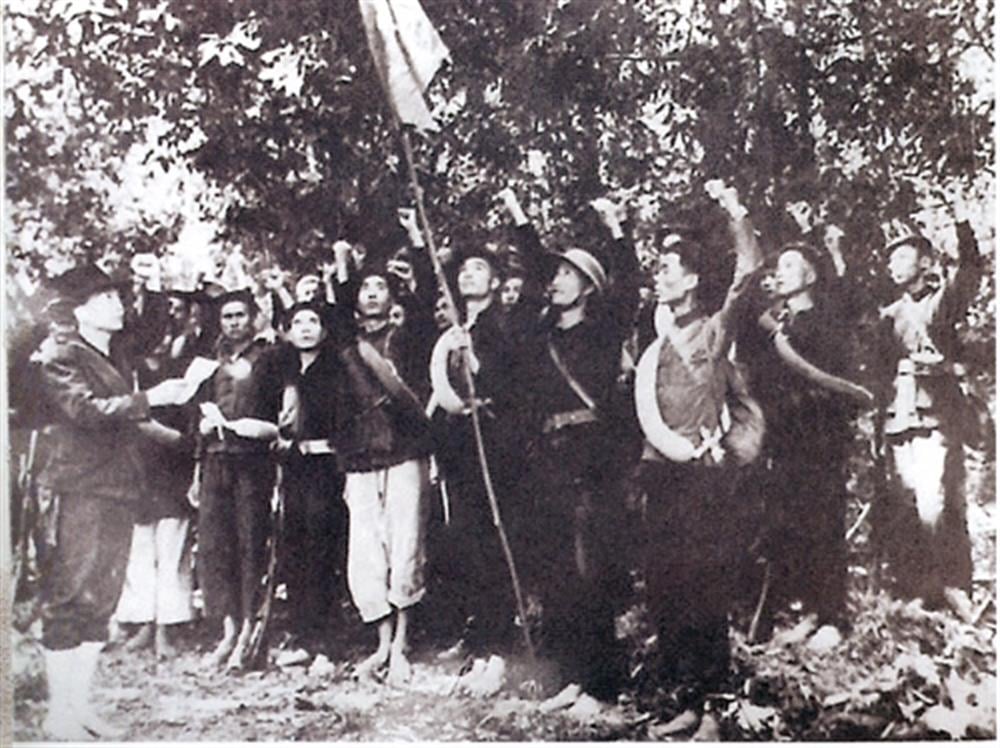 |
| The Vietnam Propaganda Liberation Army, the predecessor of the Vietnam People's Army, was established on December 22, 1944 in Tran Hung Dao forest ( Cao Bang ). |
Right after its founding, at 5:00 p.m. on December 25, 1944, the Vietnam Propaganda Liberation Army team cleverly, boldly, and suddenly broke into Phai Khat post and at 7:00 a.m. the next morning (December 26), broke into Na Ngan post (both located in Nguyen Binh district, Cao Bang province), killed two post commanders, captured all enemy soldiers, and seized weapons, military uniforms, and military equipment. The victory at Phai Khat and Na Ngan marked the beginning of the tradition of determination to fight and win of the Vietnam People's Army.
In April 1945, the Party's Northern Revolutionary Military Conference decided to merge revolutionary armed organizations across the country into the Vietnam Liberation Army. During the August Revolution of 1945, the Vietnam Liberation Army, together with local armed forces and the People, carried out a General Uprising to seize power across the country. After the success of the August Revolution of 1945, the Vietnam Liberation Army was renamed the National Guard, then the Vietnam National Army (1946), and from 1950 it was called the Vietnam People's Army.
2. The Vietnam People's Army in the resistance war against the French colonialists (1945 - 1954)
When the French colonialists invaded our country for the second time, under the leadership of the Party, the armed forces developed strongly, together with our people, stood up and fought the invaders. At the end of 1946, according to the decision of President Ho Chi Minh, the whole country was divided into 12 war zones. At this time, in the South, the National Guard units were still organized, in the North and Central regions there were 30 regiments and a number of battalions in the war zones; the party organization system in the Army was established from the Central Military Commission to the party cells.
On the night of December 19, 1946, the nationwide resistance war broke out. In the first days of the national resistance war, our army and people fought hundreds of battles, eliminated thousands of enemies, and destroyed many enemy war vehicles. In the spring of 1947, President Ho Chi Minh, the Party Central Committee and the Government went to Viet Bac, which became the center of command for the resistance war of the whole country.
In the fall and winter of 1947, the French colonialists mobilized more than ten thousand elite troops with the support of aircraft and warships to suddenly attack Viet Bac to destroy our resistance headquarters and main force troops. After more than two months of launching a counter-offensive campaign (October 7 - December 20, 1947), we eliminated more than 7,000 enemies from the battle. This was the first large-scale counter-offensive campaign that achieved a strategic victory for our army and people; defeated the large-scale attack and bankrupted the French colonialists' strategy of "fighting fast, winning fast"; preserved and developed the main force troops, protected the headquarters and bases of the whole country.
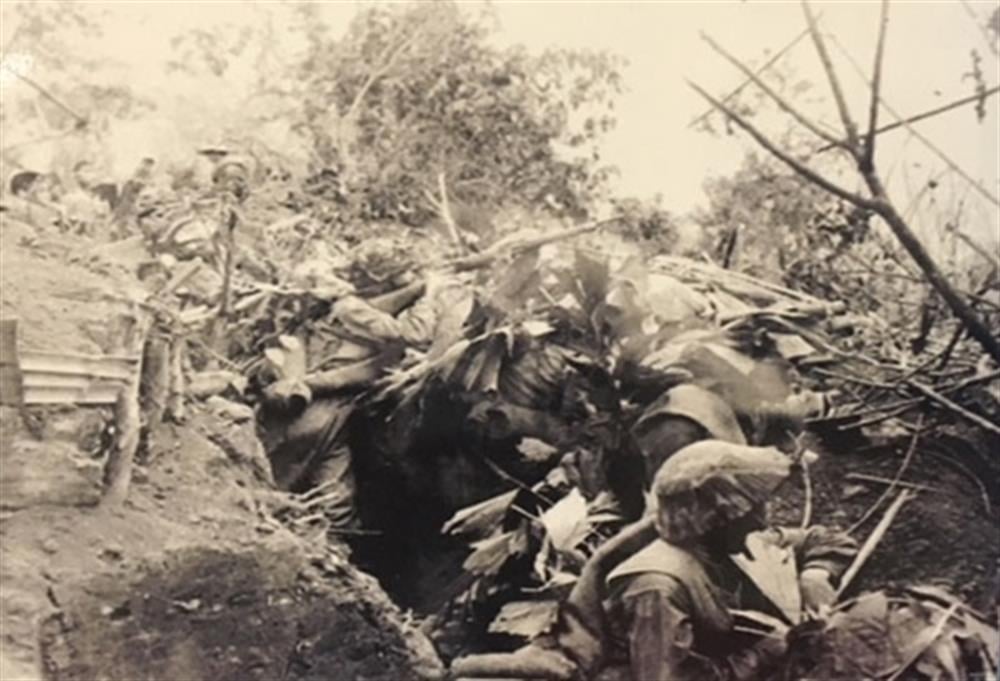 |
| Troops surrounded and attacked the enemy in the Hoa Binh campaign in 1952. |
After the Viet Bac campaign in 1947, our army had matured, but was not yet capable of launching large-scale campaigns. To defeat the enemy's pacification plot, we advocated launching widespread guerrilla warfare and implementing "independent companies and concentrated battalions", both promoting guerrilla warfare and learning concentrated mobile warfare. Concentrated battalions were consolidated and gradually advanced to fight larger ambushes and raids. From early 1948 to mid-1950, our troops continuously launched over 20 small campaigns on the battlefields. The concentration level for each campaign was from 3 to 5 battalions, then gradually increased to 2 to 3 regiments, with some campaigns using both mountain artillery and heavy machine guns. In many battles, our army destroyed enemy companies and battalions outside fortifications and destroyed strongholds with more or less than one enemy company stationed there.
From mid-1949, the General Command advocated withdrawing independent companies to build main regiments and divisions. On August 28, 1949, Division 308 was established; on March 10, 1950, Division 304 was established. Training was stepped up. Through the campaigns of "training soldiers to make achievements" and "forging cadres and rectifying troops" in 1948, 1949 and early 1950, our armed forces continuously developed and grew stronger.
In June 1950, the Party Central Committee decided to launch the Border Campaign, proactively attacking the French. After nearly a month (September 16 - October 14, 1950), we eliminated more than 8,000 enemies from combat, liberated the border area from Cao Bang to Dinh Lap (Lang Son), the Viet Bac base was expanded and consolidated, broke the siege, opened communication with China and socialist countries, and connected our country's revolution with the world revolution. The Border Victory contributed significantly to changing the situation of the war: We entered the strategic phase of counter-attack and attack, the French army gradually switched to a defensive strategy; at the same time, it marked a leap forward in the development of campaign art and the growth and maturity of our Army.
After the Border Campaign, the main divisions continued to be established: Division 312 (December 1950), Division 320 (January 1951), Artillery Division 351 (March 1951), Division 316 (May 1951). Within 6 months (December 1950 - June 1951), we consecutively launched three campaigns named: Tran Hung Dao, Hoang Hoa Tham, Quang Trung. These were the first large-scale campaigns to attack the enemy's fortified defense lines in the midlands and deltas of the North. We killed more than 10,000 enemies, of which nearly half were mobile troops.
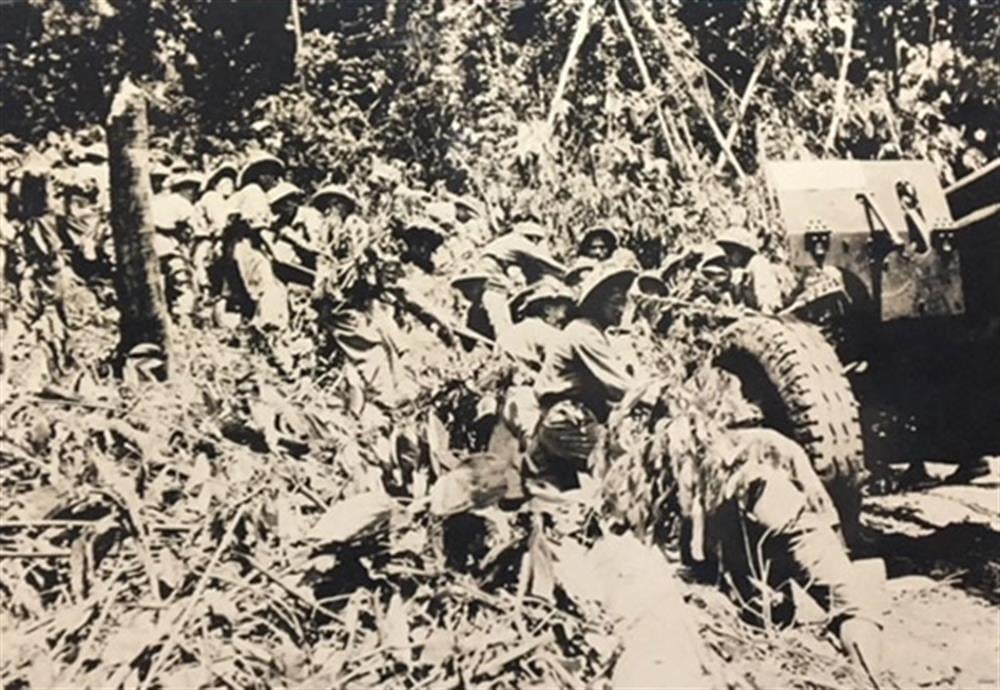 |
| Soldiers pull artillery into the battlefield during the Dien Bien Phu Campaign in 1954. |
In November 1951, the Politburo decided to launch the Hoa Binh campaign; focusing on the main force on the main Hoa Binh front, while putting a part of the main force into operation in the enemy's rear area of the Northern Delta, stepping up guerrilla warfare in the temporarily occupied enemy area. The campaign took place from December 10, 1951 to February 25, 1952; our army and people eliminated from combat more than 6,000 enemies on the Hoa Binh front and more than 15,000 enemies on the enemy's rear front. In this campaign, our troops made new progress in terms of tactics, techniques, long-term continuous combat capability, and coordination between the three types of troops.
In early September 1952, the Politburo decided to launch the Northwest campaign. After nearly two months of fighting (October 14 - December 10, 1952), we destroyed and captured more than 6,000 enemies, liberated a large area in an important strategic area, connected the Northwest liberated area with the Viet Bac and Upper Laos bases, maintained the initiative in the attack, and defeated the enemy's plot to expand its occupation.
On December 5, 1952, in Binh - Tri - Thien, the 325th Division was established, contributing to increasing the fighting strength of the "revolutionary main punches". Up to this point, the main army under the General Command had 6 infantry divisions (308, 304, 312, 320, 316, 325) and 1 engineering and artillery division (351).
Faced with the changes in the war situation in Indochina, based on a correct assessment of the comparative strength between us and the enemy, in September 1953, the Politburo decided to launch the 1953-1954 Winter-Spring strategic offensive. Implementing that policy, the General Command ordered the main units to coordinate and launch strong offensives on the battlefields. We formed five strategic offensives in Lai Chau, Central Laos, Lower Laos - Northeast Cambodia, Central Highlands and Upper Laos, destroying many enemy forces, liberating many large areas of land, forcing them to spread out to deal with them everywhere.
After the French colonialists landed troops to occupy Dien Bien Phu, on December 6, 1953, the Politburo met to decide to launch the Dien Bien Phu campaign. After 56 days and nights (March 13 - May 7, 1954) of continuous fighting, our army and people crushed the entire Dien Bien Phu stronghold, eliminated 16,200 enemy soldiers from combat, shot down and destroyed 62 planes; captured all weapons, warehouses, and technical facilities of the enemy in Dien Bien Phu. The Dien Bien Phu victory dealt a decisive blow to the will to invade, forcing the French colonialists to sign the Geneva Agreement on the cessation of hostilities in Vietnam. The Dien Bien Phu campaign is an outstanding example, the pinnacle of Vietnamese military art in the resistance war against France; At the same time, it is a testament to the remarkable development of our Army after 10 years of building, fighting and glorious victory (1944 - 1954).
3. The Vietnam People's Army in the resistance war against the US to save the country (1954 - 1975)
The victory of the resistance war against French colonialism and American intervention opened a new stage of development of the Vietnamese revolution. The North was completely liberated and entered the transition period to socialism. The South continued the people's national democratic revolution, overthrowing the domination of American imperialism and its lackeys. To meet the requirements of the Vietnamese revolution in the new stage, in March 1957, the 12th Central Conference (enlarged) issued a Resolution on the issue of building the Army and strengthening national defense. The Resolution clearly stated: "Our motto for building the army is to actively build a strong people's army, gradually moving towards regularization and modernization" [5].
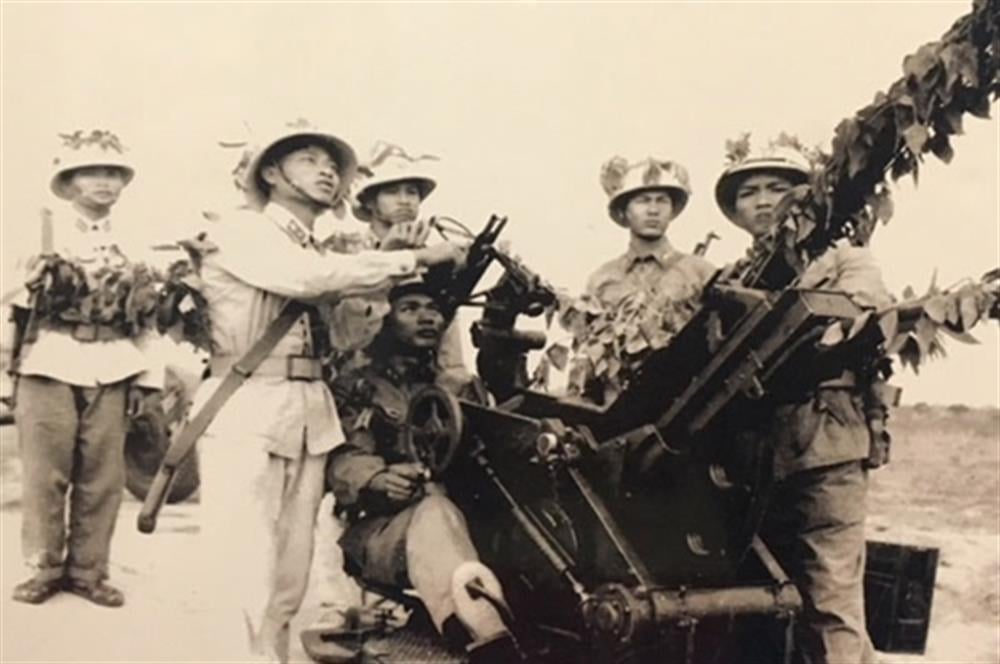 |
| Artillery Battalion 14, Vinh Quang Group, excellent training unit in 1959. |
By 1960, our Army had reached a new stage of maturity, from a force that was mainly infantry with an ununified organization and lacking weapons and equipment, it had become a regular, increasingly modern Army, consisting of the following forces: Army, Navy, Air Defense - Air Force. This was a very important development step, creating the foundation for building a regular, modern Army, ready to meet the new tasks of the revolution.
In the North, the Army actively participated in the takeover of cities, towns and areas previously occupied by the French. It performed well the military administration task, coordinated with the police forces to quickly establish order and security, protect the lives and property of the people, and fight against the enemy's arrest, robbery and destruction of public property.
In the South, during the years 1954 - 1960, the US - Diem carried out a brutal terrorist policy, causing heavy losses to the Southern revolution. In that situation, the 15th Conference of the Central Executive Committee of the Party, Session II (January 1959) raised two strategic tasks of the Vietnamese revolution and clearly outlined the basic path of the Southern revolution, which was to use revolutionary violence. In compliance with the Party's resolution, the General Military Commission and the Ministry of National Defense decided to further promote the building of the Army. Preparations for our troops to fight in the South were also promoted. Accordingly, the 338th Division of the Southern troops gathered in the North was trained before leaving for the South to fight. On May 19, 1959, Group 559 was established with the task of opening a road along the Truong Son mountain range to ensure our forces could fight in the South and transport food, guns and ammunition from the North to the South. Next, Group 759 was also established with the mission of transporting and supplying from the North to the South by sea.
The Resolution of the 15th Conference paved the way for the Southern revolution to win. To promote the revolutionary movement of the masses, on December 20, 1960, the National Liberation Front of South Vietnam was born. On February 15, 1961, the Liberation Army of South Vietnam was established on the basis of unifying the people's armed forces in the South; this was a part of the Vietnam People's Army directly operating on the Southern battlefield.
Since 1961, the US imperialists have carried out the “Special War” strategy. Commanded by US advisors and relying on US firepower, the Saigon puppet army continuously launched operations to attack liberated areas, gathering people to establish “strategic hamlets”. Our army and people have continuously fought, maintained and expanded liberated areas. In particular, the typical victory of Ap Bac (January 1963) marked the failure of the “helicopter transport” and “armored vehicle transport” tactics of the Saigon puppet army; at the same time, it opened the “Ap Bac emulation, kill the enemy and make achievements” movement throughout the South.
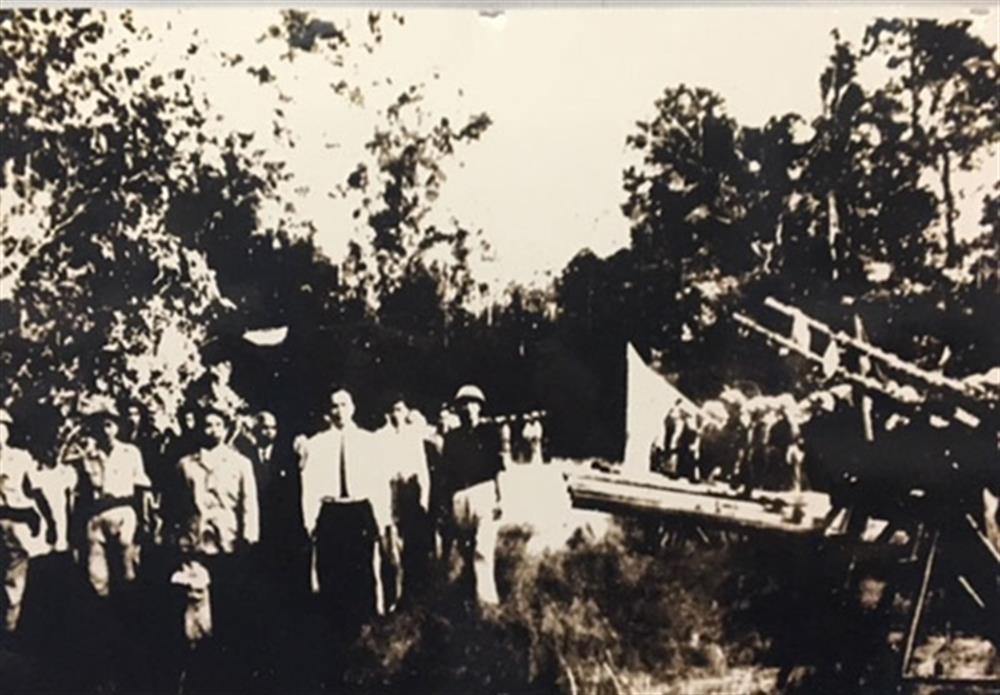 |
| Comrade Nguyen Huu Tho, Chairman of the National Liberation Front of South Vietnam, reviewed the Guard of Honor at the ceremony to unify the armed forces of the Southern Liberation Army in 1961. |
On August 5, 1964, after fabricating the “Gulf of Tonkin” incident, falsely accusing the Vietnam People’s Navy of deliberately attacking a US destroyer in international waters to deceive public opinion, the US government used the air force to suddenly launch an attack called “Piercing Arrow”, attacking most of our naval bases along the northern coastal strip. Thanks to prior preparation, the naval, air defense, and militia units promptly detected, fought intelligently and bravely, shot down 8 planes, injured 2 others, and captured 1 pilot. The first victory over the US air force encouraged the determination of the army and people of the whole country to defeat the American invaders.
Based on the victories in 1963 and early 1964, in October 1964, the Central Military Commission instructed the armed forces of the South to launch the Winter-Spring campaign of 1964-1965, destroying an important part of the puppet main force and expanding the liberated areas. After our victories in the Binh Gia, Ba Gia, and Dong Xoai campaigns, the US imperialists' "Special War" strategy was completely bankrupt.
From mid-1965, the US imperialists switched to the “Local War” strategy, massively sending US and allied combat troops and a large amount of war equipment into South Vietnam[6], while consolidating and strengthening the puppet army. The entire strategic goal of the US imperialists during this period was to “search and destroy” the main force of the Liberation Army and the revolutionary leadership agency in the South, “pacify” the South, intimidate the resistance spirit of the Vietnamese people, and force the Government of the Democratic Republic of Vietnam to sit at the negotiating table under the conditions imposed by the US.
Faced with that situation, from September to December 1965, the Ministry of National Defense decided to establish in the Southern battlefield 5 infantry divisions (9, 3, 2, 5, 1) and an artillery unit equivalent to the division level with the code name Artillery Group 69. While building and fighting, our troops on the Southern battlefields organized attacks, broke many large-scale operations of the US - puppet, opening the movement of "finding the US to fight", "finding the puppet to destroy".
In the dry season of 1965-1966, the US imperialists launched the first strategic counter-attack on the Southern battlefield. After half a year of arduous and fierce fighting, the army and people of the South defeated the enemy's counter-attack, eliminating tens of thousands of enemies from the battle. In October 1966, the US imperialists decided to launch the second strategic counter-attack to destroy the main force and the headquarters of the Southern revolution. Based on the highly developed people's war situation, our local armed forces held their ground, attacked widely, creating conditions for the main units of the Liberation Army to launch attacks, causing the enemy many losses in terms of manpower and means of war, forcing the US army to end the second strategic counter-attack in the dry season of 1966-1967.
After the important victories of the Southern revolution, in January 1968, the 14th Central Conference passed the Resolution of the Politburo (December 1967), deciding to launch the General Offensive and Uprising in the Spring of Mau Than 1968. In just a short time, our army and people attacked a series of targets deep in urban areas throughout the South, causing heavy losses to the enemy, upsetting the strategic position of the US imperialists. The victory of the General Offensive and Uprising in the Spring of Mau Than 1968 dealt a decisive blow to the will to invade of the US authorities, bankrupting the "Local War" strategy, forcing the US to de-escalate the war, gradually withdraw its troops, and accept negotiations with us at the Paris Conference.
With a stubborn and belligerent nature, the US imperialists were not willing to accept defeat. Since 1969, they have switched to implementing the "Nixon Doctrine" and the "Vietnamization of the War" strategy. During the years 1969 - 1972, the US imperialists used their military power to the maximum, combined with extremely cunning political and diplomatic tricks, in order to isolate and suffocate the resistance of our people. In that situation, our army and people closely coordinated with the fight of the Lao and Cambodian people, winning great victories, typically the Route 9 - Southern Laos campaign, the Northeast Cambodia campaign; at the same time, launching strategic offensives on the entire Southern battlefield with joint offensive campaigns in Tri - Thien, the Northern Central Highlands, the Southeast, and combined offensive campaigns in the Mekong Delta and the Central region.
Faced with the risk of failure of the “Vietnamization of the war” strategy, on April 6, 1972, the US imperialists mobilized a large air force and navy to launch a second war of destruction against the North (Operation Linebacker I) on a larger scale and more fiercely than the previous time. With a brave spirit and clever, creative fighting style, after 7 months of fierce fighting, the army and people of the North shot down 654 planes, sank and burned 125 US warships.
Faced with heavy defeats, on the night of December 18, 1972, the US imperialists recklessly launched the largest-scale strategic air raid called “Operation Linebacker II” to attack the North, focusing heavily on Hanoi and Hai Phong. Once again, the army and people of the North fought bravely, defeating the enemy’s strategic raid; shooting down 81 planes, including 34 B-52s and 5 F-111s. Suffering great losses and failing to achieve their goals, the US imperialists were forced to declare a halt to bombing the North from the 20th parallel north and resume negotiations in Paris. World public opinion called this the “Dien Bien Phu in the air”.
The great victories of our army and people on the Southern battlefield, together with the “Hanoi – Dien Bien Phu in the air” victory, forced the US imperialists to sign the Paris Agreement on ending the war, restoring peace in Vietnam (January 27, 1973), and withdrawing their troops. However, the Saigon puppet government blatantly violated the Agreement, vigorously implemented the plan of “flooding the territory”, and stepped up encroachment on our liberated zones.
To end the war soon, at the request of the Central Military Commission and the Ministry of National Defense, from late 1973 to early 1975, the Politburo approved the establishment of army corps: Army Corps 1 (October 1973), Army Corps 2 (May 1974), Army Corps 4 (July 1974), Army Corps 3 (March 1975) and Group 232 (equivalent to an army corps, February 1975). The establishment of the main army corps marked a new step in the development of the Vietnam People's Army.
During the two years 1973 - 1974, our army and people continuously won important victories, making the situation on the battlefield continue to change in our favor. The Politburo Conference in October 1974 and early 1975 pointed out the emergence of historical opportunities and expressed the strategic determination to liberate the South. Implementing the Politburo's policy, on March 4, 1975, our army launched the Central Highlands campaign, opening the 1975 Spring General Offensive and Uprising. After a number of battles to create momentum and create a diversionary campaign, on March 10 and 11, 1975, our army attacked and liberated Buon Ma Thuot town. Then, completely liberated Kon Tum, Gia Lai provinces and the entire Central Highlands.
One day after the Tay Nguyen campaign broke out, on March 5, 1975, our army launched the Tri Thien - Hue campaign, liberating Quang Tri province, Hue city and Thua Thien province. Promoting the victory, from March 26 to March 29, 1975, our army launched the Da Nang campaign, completely liberating Da Nang, Son Tra peninsula and Hoi An town. Coordinating with the armed forces and local people, our army attacked and liberated the provinces of Binh Dinh, Phu Yen (April 1), Khanh Hoa (April 3)...
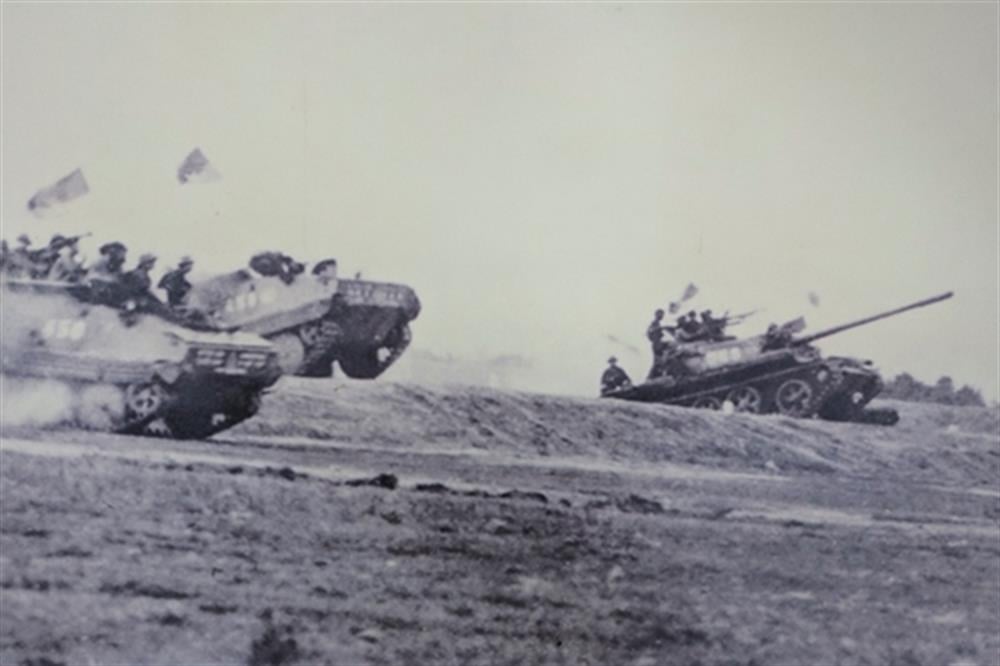 |
| The 1st Corps' thrust force crossed Highway 16 to liberate Saigon. |
From those victories, the Politburo decided to liberate Saigon and the entire South. The campaign to liberate Saigon was named "Ho Chi Minh Campaign". Implementing the guiding ideology: "Speed, boldness, surprise, sure victory", on April 26, our army formed a siege of Saigon from 5 directions, with the 1st, 2nd, 3rd, 4th Corps, Group 232 and Division 8 (Military Region 8) in charge. At 5:00 p.m. on April 26, the campaign began. After many fierce battles to capture the outer perimeter, on the morning of April 30, our army launched a general attack on Saigon's inner city, quickly penetrating deep to capture key targets; at 10:45 a.m., the 2nd Corps' penetrating force captured the Independence Palace, captured the entire Saigon government cabinet, and forced President Duong Van Minh to declare unconditional surrender. At 11:30 a.m. the same day, the flag of the Liberation Army was planted on the roof of the Independence Palace, marking the complete victory of the historic Ho Chi Minh Campaign.
In parallel with the victorious land attacks, implementing the direction of the Central Military Commission and the General Command, the Navy urgently prepared its forces, seized the opportunity, and cleverly, boldly, and suddenly launched attacks to liberate the islands of the Truong Sa archipelago: Song Tu Tay (April 14), Son Ca (April 25), Nam Yet (April 27), Sinh Ton (April 28), Truong Sa (April 29). This was a victory of strategic significance, contributing to maintaining national sovereignty in the Truong Sa archipelago.
The Ho Chi Minh Campaign was the largest-scale combined arms and military campaign, achieving the greatest victory, marking a remarkable step forward in the maturity of our Army in both force organization and command level of combined arms and military operations; it was the pinnacle of Vietnamese military art, contributing decisively to the end of the resistance war against the US to save the country.
4. The Vietnam People's Army in the cause of building and defending the Fatherland (1975 - 2024)
Immediately after the successful end of the resistance war against the US to save the country, the Army units stationed in the newly liberated areas coordinated with the Military Management Committees at all levels to urgently build and consolidate the grassroots revolutionary government, build local political forces and armed forces; organize the reform of police soldiers of the old government apparatus, suppress reactionary elements and organizations, etc. At the same time, the units actively participated in labor production, economic development, and participated in the construction of many key projects in all regions of the country.
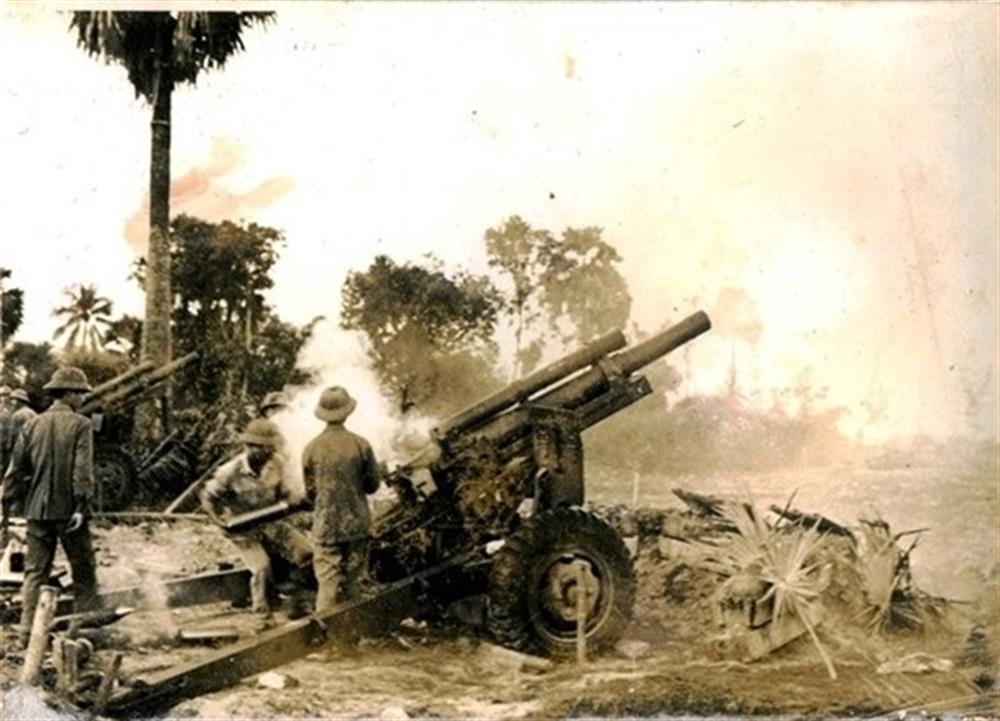 |
| Artillery of our Army in the battle to protect the Southwestern border in September 1977. Documentary photo |
After the great victory in the spring of 1975, our Army had to wage a just war to protect the southwestern border of the Fatherland and, together with the Cambodian army and people, overthrow the Pol Pot genocidal regime. In response to the invasion of the Pol Pot army and in response to the urgent call of the Cambodian United Front for National Salvation, the Vietnamese Volunteer Army, together with the Cambodian revolutionary armed forces, launched a strong counter-attack, overthrowing the Pol Pot genocidal regime, liberating the capital Phnom Penh on January 7, 1979, and moving towards liberating the entire country of Cambodia. During 10 years (1979 - 1989), the Vietnamese Volunteer Army and experts promoted the pure international spirit, together with the Cambodian army and people to hunt down the remnants of the Pol Pot army, consolidate the revolutionary government, build the armed forces, and revive the country.
Also in early 1979, our army and people had to fight to protect the northern border of the Fatherland. The battle lasted for a short time (February 17 - March 6, 1979), but in reality the tense situation at the northern border lasted until the end of the 1980s. In this battle, our army and people fought bravely, firmly protecting the sovereignty of the border and territory of the Fatherland.
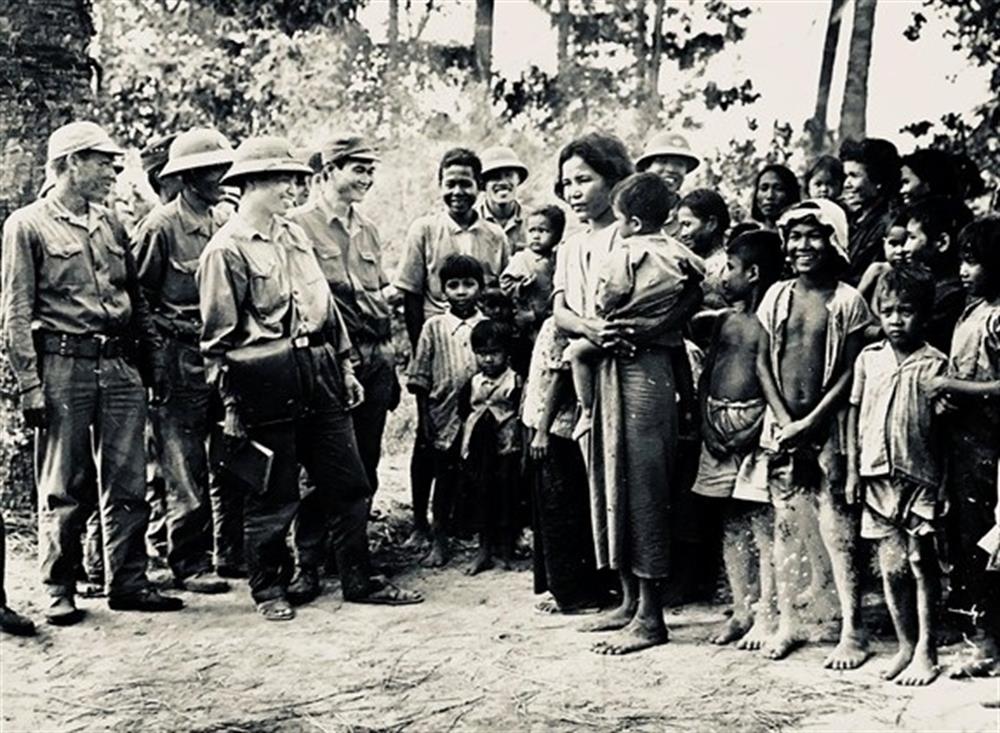 |
| A delegation of Vietnamese volunteer soldiers visited and provided relief to Cambodian people right after the country escaped the genocidal regime. Photo courtesy |
The victory of our army and people in the war to protect the southwestern border and the fight to protect the northern border of the Fatherland has great historical significance, firmly protecting the independence, sovereignty, unity and territorial integrity of the Fatherland, creating a peaceful environment for national development.
During the years 1980 - 1986, our Army promoted training, combat readiness, education and training, and established a regular order; actively participated in economic and social development. The entire Army organized hundreds of large-scale joint military exercises with many modern technical weapons in strategic areas, contributing to training and improving the command and organization capacity of officers and combat readiness of soldiers.
Since the 6th National Party Congress (December 1986) up to now, the Army and the entire people have carried out the cause of national renewal, building and defending the socialist Fatherland of Vietnam. For nearly 40 years of implementing the cause of renewal, the Army has always performed well the functions of a combat army, a working army, a production labor army, making worthy contributions to the common achievements of the country. Notably:
– The army regularly grasps and accurately forecasts the situation, proactively advises the Party and State to propose appropriate countermeasures, flexibly and successfully handles situations, avoids being passive or surprised in strategy, prevents the risk of war, maintains independence, sovereignty, unity, territorial integrity, ensures political stability, creates a favorable environment for socio-economic development. Advises on the issuance of the Resolution of the Party Central Committee on "Strategy for protecting the Fatherland in the new situation", strategies, draft laws, and projects on military and national defense. Promotes the core role, proactively coordinates with departments, ministries, branches, and localities in building a strong national defense, building a national defense posture, "people's hearts posture" and a solid defense area.
– The Central Military Commission and the Ministry of National Defense have issued many resolutions and directives to lead and direct the improvement of combat training quality with the consistent guiding viewpoint: “Training is a central and regular political task in peacetime”. On that basis, the entire army has regularly innovated and improved the quality of training and exercises; closely following the motto “Basic – Practical – Solid”, attaching importance to synchronous and in-depth training, in a modern direction, improving the combat mobility of troops, responding to new forms of warfare. The Ministry of National Defense has directed and successfully organized many large-scale joint military exercises, affirming the strength, combat readiness and combat capability of the Army, which has been recognized and highly appreciated by the Party and the State.
– The entire army regularly maintains strict discipline and combat readiness, grasps, assesses, and accurately forecasts the situation, especially the situation in the air, at sea, at the border, inland, abroad, and in cyberspace, promptly handles situations, and avoids being passive or surprised. Proactively and resolutely fights against "peaceful evolution" and violent overthrow, promptly detects, prevents, and foils all plots and acts of sabotage by hostile forces. Coordinates with forces to absolutely protect the safety of important political events of the country.
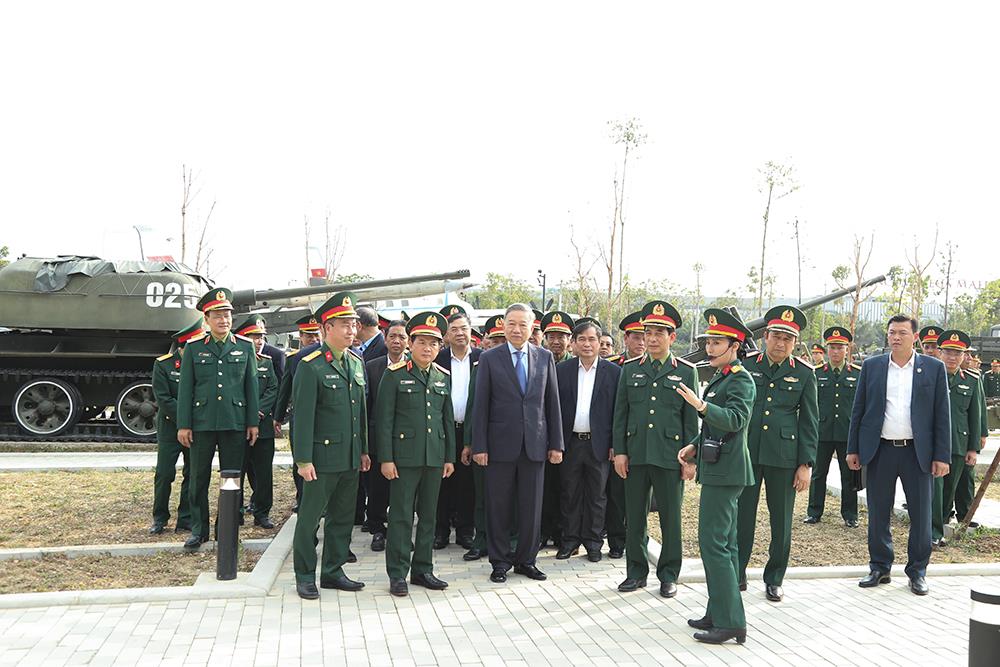 |
| General Secretary To Lam listens to an introduction to the Vietnam Military History Museum at the outdoor exhibition area. |
– The Central Military Commission and the Ministry of National Defense have led and directed the entire army to deploy many practical solutions to build a politically strong Army, as a basis for improving the overall quality and combat strength of the Army; building a clean, strong, and exemplary Army Party Committee and Party committees and organizations in the entire army, associated with building "exemplary, exemplary" comprehensively strong agencies and units. Effectively implementing the policy of building a lean, compact, and strong Army; organizing and implementing well the work of logistics, engineering and other aspects of work. In particular, the defense industry has been developed in a modern, dual-use direction; researched and mastered the technology of manufacturing and producing a number of new, modern weapons and technical equipment with Vietnamese brands. International integration and defense diplomacy have achieved many outstanding results on both bilateral and multilateral levels; actively participate in United Nations peacekeeping activities, humanitarian assistance, search and rescue, disaster relief, and war aftermath relief, highly appreciated by international friends.
– Performing the function of a working army, the Army has made important contributions to the implementation of mass mobilization work; actively propagating and mobilizing the People to successfully implement the Party's guidelines and policies, the State's policies and laws, patriotic emulation movements, revolutionary campaigns, and local political tasks; participating in building a strong grassroots political system, strengthening national defense and security, developing the economy, culture, and society; actively helping the People to eliminate hunger, reduce poverty, and build new rural areas. In particular, Army officers and soldiers have not been afraid of hardships, sacrifices, and have been at the forefront in preventing natural disasters, epidemics, and rescuing people to protect the lives and property of the People; many officers and soldiers have fallen while carrying out this noble task. The image of Army officers and soldiers always present in vulnerable and dangerous places to help people respond to natural disasters and epidemics has further illuminated the good nature of "Uncle Ho's soldiers", and is trusted and highly appreciated by the Party, State and People.
– Performing the function of a production labor force, the Army has advised and proposed to the Party and State to issue mechanisms and policies in line with the policy of economic and social development associated with strengthening national defense and security in the new period; effectively building and promoting economic-defense zones in participating in economic and social development associated with ensuring national defense and security in strategic areas, especially difficult areas, remote areas, border areas, and islands. Military enterprises are organized and arranged in accordance with the requirements of innovation in each period, both serving well the military and defense tasks and contributing to economic and social development. Units have participated in the construction of many key national projects and infrastructure projects serving people's lives, contributing significantly to national income and ensuring social security; effectively participating in the implementation of national target programs associated with the implementation of military and defense tasks. The whole army has focused on increasing production, contributing to improving the lives of soldiers.
5. Glorious tradition of the Vietnam People's Army
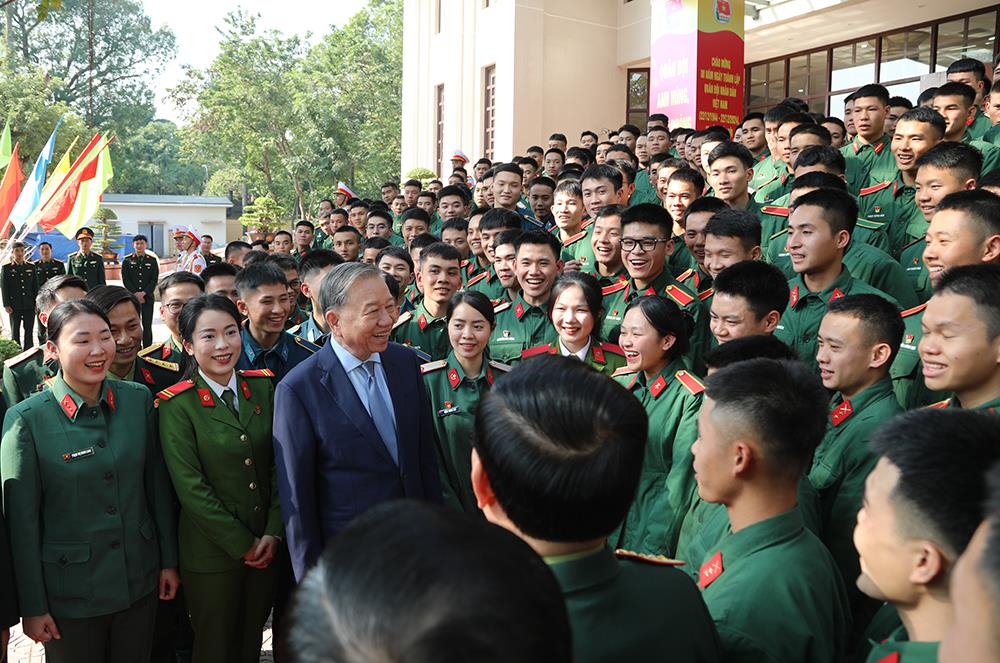 |
| General Secretary To Lam talks with young generation representatives in the Army and Police. |
Through 80 years of building, fighting, winning and growing, our Army has built a very glorious tradition, summarized concisely in the praise of President Ho Chi Minh: “Our Army is loyal to the Party, filial to the people, ready to fight and sacrifice for the independence and freedom of the Fatherland, for socialism. Every task is completed, every difficulty is overcome, every enemy is defeated”[7]. That tradition is demonstrated:
– Infinite loyalty to the Socialist Republic of Vietnam, the Party, the State and the People.
- Determined to fight, determined to win, know how to fight and know how to win.
- Blood and flesh bond with the people, army and people have one will.
– Internal solidarity; cadres and soldiers are equal in rights and obligations, love and help each other, have unity of will and action.
Self-discipline and strictness.
- Independence, autonomy, self-reliance, self-strengthening, diligence and thrift in building the army, building the country, respecting and protecting public property.
– Clean, healthy, cultured, honest, modest, simple, optimistic lifestyle.
- Always promote the spirit of learning, progress, standard and delicate behavior.
– Pure, loyal, righteous and heartfelt international solidarity.
II. HISTORY AND SIGNIFICANCE OF NATIONAL DEFENSE DAY
1. History of National Defense Day
All-people national defense is a national defense that is “for the people, by the people, of the people”, developing in the direction of: all-people, comprehensive, independent, autonomous, self-reliant, self-reliant and increasingly modern, closely combining economy with national defense and security, under the leadership of the Party, the management and administration of the State, mastered by the people, to maintain peace and stability of the country, ready to defeat all acts of invasion and riotous overthrow by imperialist and reactionary forces, firmly protecting the socialist Vietnamese Fatherland”[8].
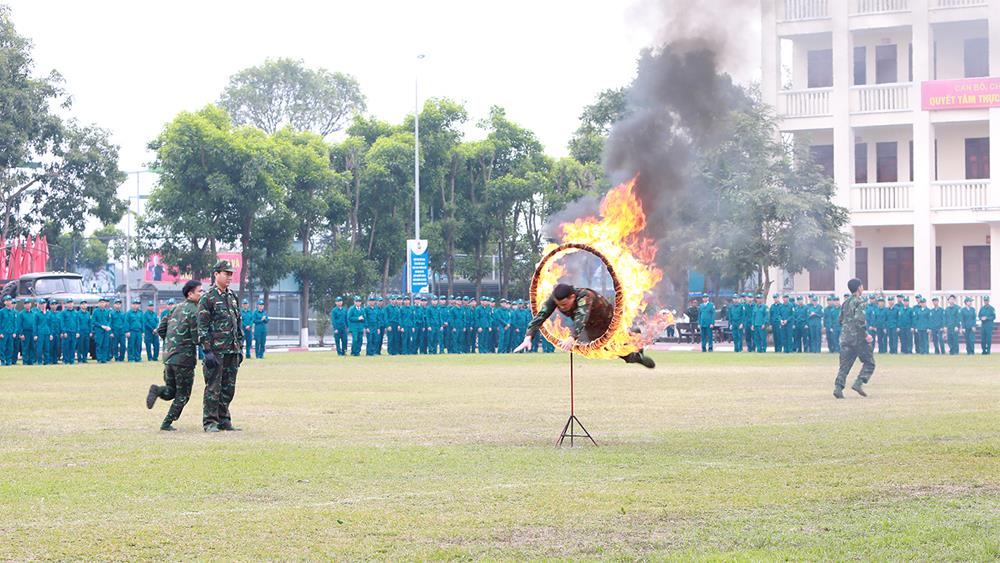 |
| December 22 is a big national festival with activities focusing on national defense and military themes. |
Our Party and State have consistently affirmed that building a strong national defense is the revolutionary cause of the entire Party, the entire people, the entire army and the entire political system, in which the people's armed forces are the core. Vietnam's national defense is a national defense of peaceful, self-defense nature and of the nature of the socialist regime. Vietnam builds its military and defense strength based on the combined strength of the whole country, of the great national unity bloc, of the entire political system led by the Communist Party of Vietnam, combining national strength and the strength of the times, the strength of the national defense force and posture with the strength of the people's security force and posture. Our Party and State advocate socio-economic development associated with strengthening national defense and security capabilities, closely coordinating defense and security activities with foreign affairs activities into a unified entity to serve the cause of building and protecting the Fatherland.
The historical reality of our nation's building and defending the country, especially the uprisings, liberation wars and wars to defend the Fatherland carried out by our people under the leadership of the Party, has demonstrated the invincible strength of the great national unity bloc. In any period, no matter how brutal the enemy is, if we can encourage, motivate and gather the strength of the entire people, our nation will achieve great victories, ensuring the sustainability of independence, freedom, sovereignty and territorial integrity.
Based on the role of propaganda, encouragement and motivation for the entire people to participate in building a strong national defense, and at the same time following the wishes of the army and people of the whole country, on October 17, 1989, the Central Party Secretariat of the 6th tenure issued Directive No. 381-CT/TW deciding to take December 22 - the founding day of the Vietnam People's Army as the National Defense Day. On December 22, 1989, for the first time, the National Defense Day was held in all localities across the country. Since then, December 22 has become a great national festival with activities focusing on the theme of national defense and the army.
2. The meaning of National Defense Day
Taking December 22 as the National Defense Day is the inheritance of the tradition of the entire people fighting to defend the country of our nation through historical periods; is a major and important policy of the Party and State; continues to affirm the viewpoint of the entire people participating in building, consolidating national defense, protecting the Fatherland, in which the people's armed forces are the core. This is truly a festival of the tradition of building and defending the country, a festival to honor and multiply the beautiful image of "Uncle Ho's soldiers", a unique feature of Vietnamese national culture in the new era.
The National Defense Day is an opportunity to widely propagate the nation's tradition of fighting to defend the country and the noble qualities of "Uncle Ho's soldiers", to educate patriotism and love for socialism; thereby raising awareness and responsibility of all people in participating in building a strong national defense associated with a solid people's war posture, strengthening the strength to protect the Fatherland. At the same time, to encourage and motivate all people to take care of building a strong people's armed force in each locality, building a powerful Vietnam People's Army in the new situation.
Every year, our entire Party, people and army have had many rich and creative activities to celebrate the anniversary of the founding of the Vietnam People's Army and the National Defense Day, such as: rallies, seminars, military-civilian solidarity conferences, military-civilian cultural festivals, organizing propaganda and educational activities with rich and diverse content and forms; organizing meetings, exchanges, traditional talks, visits and encouragement to veterans, former youth volunteers, families of martyrs, wounded and sick soldiers; cultural and artistic exchanges, sports competitions, military sports in the people's armed forces; building houses of gratitude, great solidarity houses to give to policy beneficiaries; participating in the construction, renovation, embellishment and upgrading of martyrs' cemeteries, memorials and martyrs' temples; organizing incense offerings and gratitude to heroes and martyrs...
All levels, sectors, Party committees and local authorities have focused on promoting the emulation movement of labor production, economic, cultural and social development, hunger eradication and poverty reduction, associated with building and developing national defense and security potential through programs and projects for local socio-economic development; propagating and mobilizing the masses to actively participate in building and consolidating national defense, building the all-people national defense posture, the people's security posture, and building a strong local political base. Through that, the "people's hearts posture" has been increasingly consolidated, contributing to defeating the plots and sabotage tricks of hostile forces, maintaining political stability, social order and safety for rapid and sustainable national development. The 13th Party Congress assessed: “National defense and security potential is enhanced; people's hearts and minds are focused on; the national defense and people's security posture, especially in strategic and key areas, are firmly consolidated”[9].
III. BUILDING THE ARMY, STRENGTHENING NATIONAL DEFENSE, MEETING THE REQUIREMENTS OF BUILDING AND PROTECTING THE FATHERLAND IN THE NEW SITUATION
In the coming years, the world and regional situation will continue to develop in a complex and unpredictable manner. Peace, cooperation and development are still the major trends, but they are facing many obstacles, difficulties and challenges. Major countries are both cooperating and compromising, and fiercely competing; increasing strategic adjustments, attracting and gathering forces. Many hot spots and conflicts continue to exist, with the risk of spreading. The Fourth Industrial Revolution is developing strongly, creating both opportunities and challenges for all countries and peoples. The emergence of modern weapons and military equipment, and many new forms of warfare are changing the strategic environment. Non-traditional security challenges are increasingly fierce, negatively impacting the existence and sustainable development of countries, including Vietnam.
In the country, although many achievements have been made in the socio-economic field, the macro-economy has been stable but not really solid; the country's potential has continued to be strengthened, its prestige and position in the international arena have been enhanced, but there are still many difficulties and challenges. The four risks identified by our Party still exist; signs of degradation in political ideology, ethics, lifestyle, "self-evolution", "self-transformation" within the Party, corruption has not been pushed back; the degradation of some cultural and ethical values, and conflicts and frustrations in society are still complicated. The sovereignty dispute in the East Sea still has the potential to cause instability. Hostile and reactionary forces have intensified their sabotage of the Party, the State and the Army with increasingly open, direct and sophisticated plots and tricks.
 | ||
|
That situation poses new difficulties and challenges for the cause of building the Army, consolidating national defense, and protecting the Fatherland in the coming years; requiring the entire Party, the entire people, and the entire army to bring into full play the combined strength of the entire nation and the entire political system in combination with the strength of the times, making the most of the sympathy and support of the international community to firmly protect the independence, sovereignty, unity, and territorial integrity of the Fatherland, protect the Party, the State, the People, the socialist regime, the culture, and national interests; maintain a peaceful environment, political stability, national security, and human security; build an orderly, disciplined, safe, and healthy society to develop the country in the direction of socialism.
Promoting valuable lessons learned in the history of the nation's struggle to defend the country, in the history of building, fighting and winning of the Vietnam People's Army, we continue to maintain and strengthen the absolute, direct leadership in all aspects of the Party, the centralized, unified management of the State over the People's Army and the cause of consolidating national defense and protecting the Fatherland. Thoroughly grasp and effectively implement the policy of all-people national defense and people's war; arouse and promote the people's mastery, the will of self-reliance, self-strengthening, fine cultural traditions, the strength of the great national unity bloc to successfully carry out the cause of building and protecting the Fatherland.
Strengthening the building of all-people national defense associated with people's security, all-people national defense posture associated with people's security posture and a solid "people's heart posture". Strengthening propaganda and education, raising awareness and responsibility of the whole society for the task of strengthening national defense, security and protecting the Fatherland. Innovating and improving the quality and effectiveness of education and training on national defense and security knowledge for all subjects; focusing on propaganda and education to raise awareness of partners and subjects of the Vietnamese revolution, the Party's guidelines and viewpoints, requirements of the task of protecting the Fatherland in the new situation, fostering a sense of responsibility and revolutionary vigilance in performing national defense and security tasks.
Focus on building the potential, forces, and defense posture, improving sustainability and mobilization capacity to meet defense mission requirements in all situations. Build solid defense zones at all levels, create a comprehensive defense arrangement in each locality and nationwide. Closely and effectively combine the economy, culture, society, foreign affairs with defense and security, and between defense and security with economy, culture, society and foreign affairs in accordance with the guiding viewpoint: "Socio-economic development is the center; Party building is the key; cultural development is the spiritual foundation; ensuring defense and security is essential and regular".
Building a revolutionary, regular, elite, and gradually modern People's Army, with a number of military branches, services, and forces advancing straight to modernity. By 2025, basically building an elite, compact, and strong Army, creating a solid foundation, striving to build a revolutionary, regular, elite, and modern People's Army by 2030; strong in politics, ideology, ethics, organization, and personnel. Adjusting the Army's organization in the direction of being elite, compact, and strong, associated with the rearrangement of forces and improving the quality of attracting and training talents and high-quality human resources in the Army. Maintaining and promoting the glorious tradition of the Army, the noble qualities of "Uncle Ho's soldiers" and Vietnamese military art; performing well the functions of "combat army, working army, production labor army"; being ready with plans to firmly protect independence, sovereignty, unity, and territorial integrity, and responding to non-traditional security threats; Enhance the capacity to prevent and combat cyber warfare and information warfare. At the same time, pay attention to and take good care of implementing policies towards the Army and policies for the army's rear.
Continue to improve the effectiveness of international integration and defense diplomacy in the spirit of Conclusion No. 53 dated April 28, 2023 of the Politburo and Resolution No. 2662-NQ/QUTW dated February 26, 2024 of the Central Military Commission on international integration and defense diplomacy until 2030 and the following years. Thoroughly grasp and well implement the motto "active, proactive, confident, flexible, effective" in international integration and defense diplomacy, firmly adhere to Vietnam's "Four Nos" defense policy in international relations (not participating in military alliances, not allying with one country to fight another, not allowing foreign countries to set up military bases or use Vietnamese territory to fight against other countries, not using force or threatening to use force in international relations). From there, we will maximize the consensus and support of the international community, strengthen strategic trust, maintain a peaceful, cooperative and mutually developing environment, and contribute to protecting the Fatherland "early and from afar".
The 80th anniversary of the founding of the Vietnam People's Army and the 35th anniversary of the National Defense Day is an opportunity for us to review the heroic history of the nation, the nature, fine traditions, and glorious feats of arms of our Army and people; thereby, arousing national pride and self-respect, promoting revolutionary heroism, enhancing patriotism, love for socialism, the will to be self-reliant and self-reliant, overcoming all difficulties and challenges; striving to build a strong national defense, build a national defense posture associated with a solid people's security posture, build a revolutionary, disciplined, elite, and modern People's Army in the coming years in the spirit of the Resolution of the 13th National Party Congress, meeting the requirements of the task of protecting the socialist Vietnamese Fatherland in the new period.
Source: https://bocongan.gov.vn/tin-tuc-su-kien/quan-doi-nhan-dan-viet-nam—80-nam-xay-dung-chien-dau-chien-thang-va-truong-thanh-d17-t42812.html


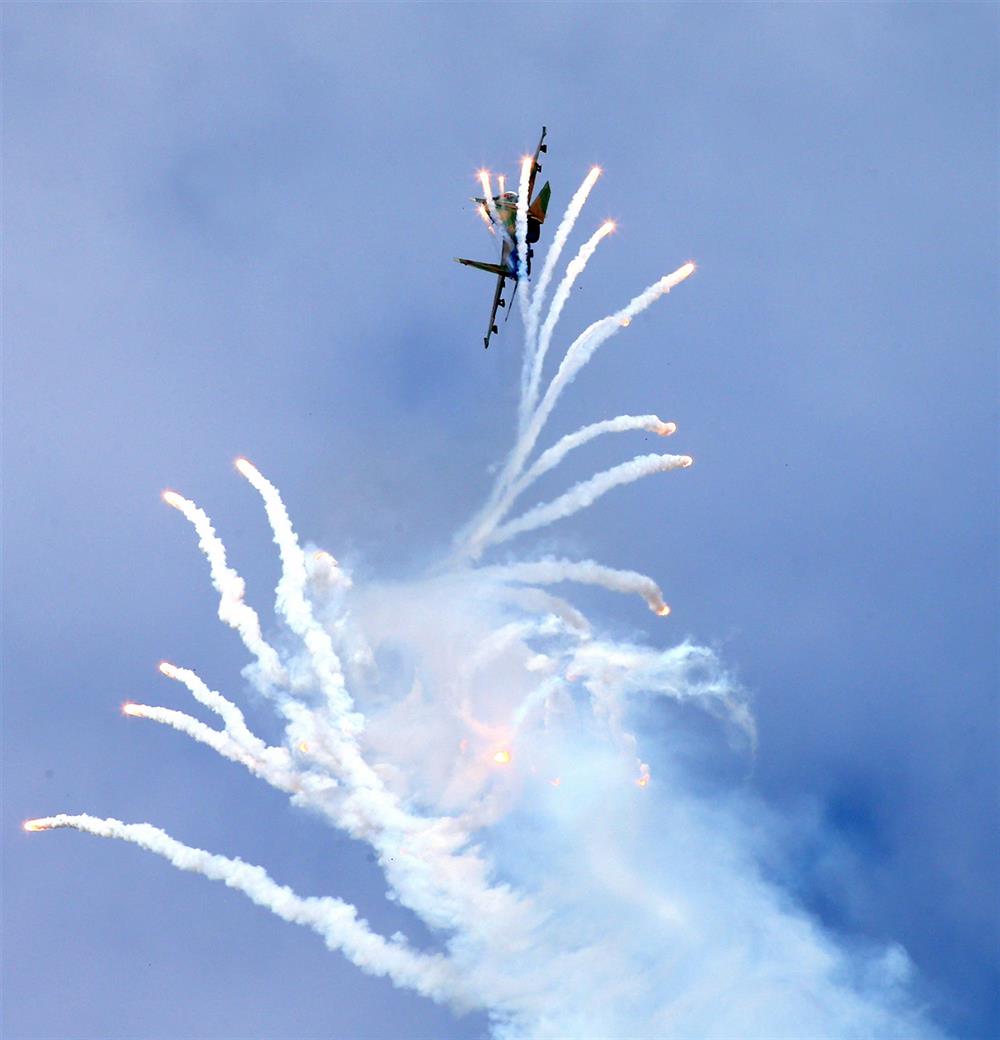

![[Photo] Cutting hills to make way for people to travel on route 14E that suffered landslides](https://vphoto.vietnam.vn/thumb/1200x675/vietnam/resource/IMAGE/2025/11/08/1762599969318_ndo_br_thiet-ke-chua-co-ten-2025-11-08t154639923-png.webp)


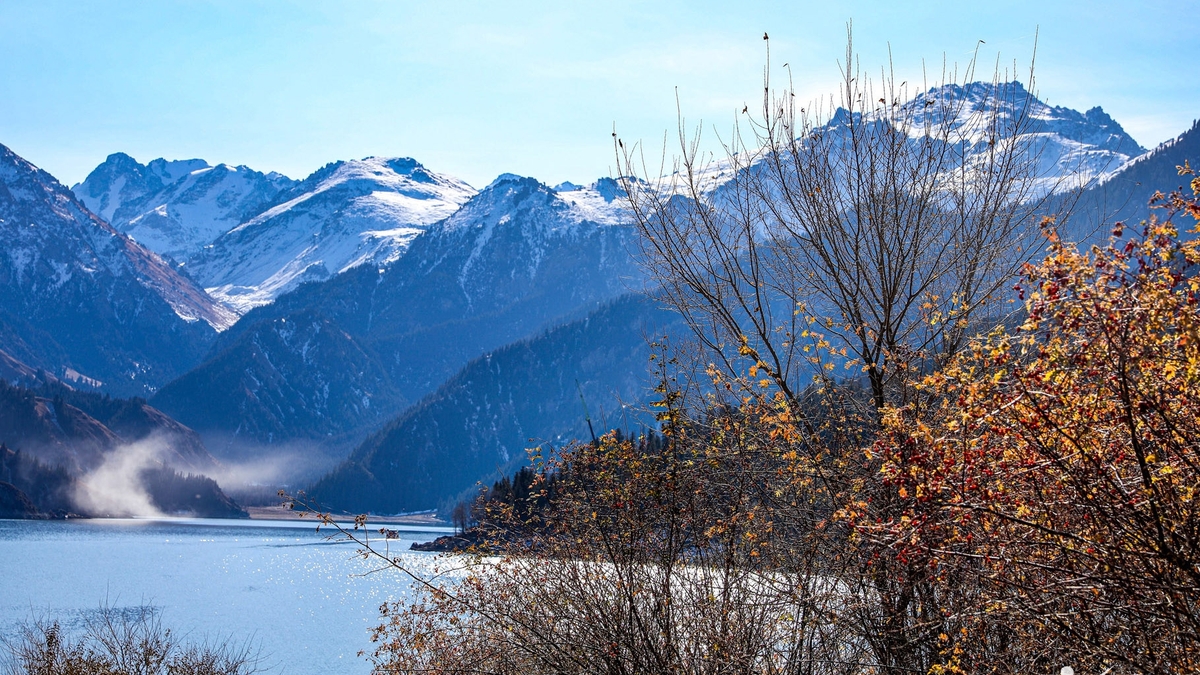

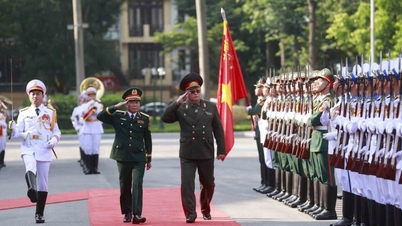

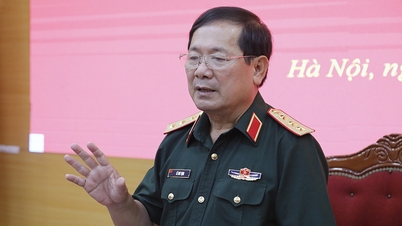






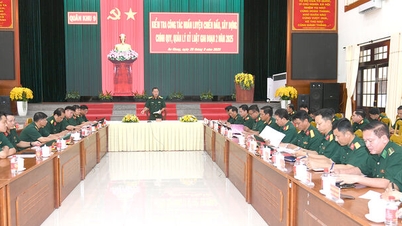



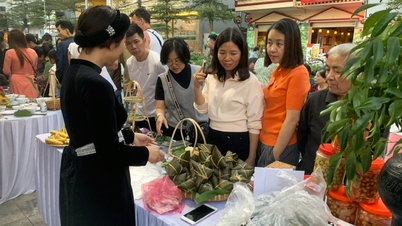




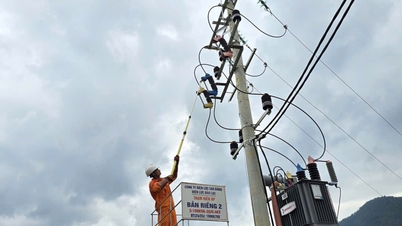

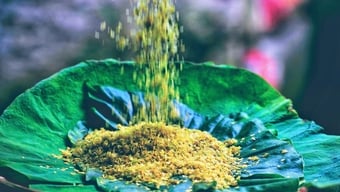





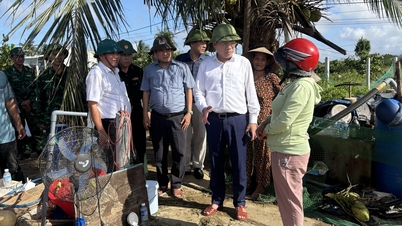
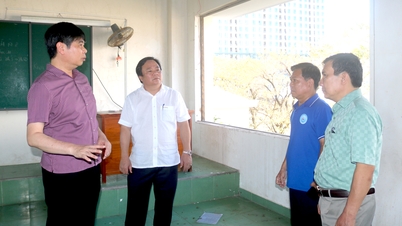







![[Video] Hue Monuments reopen to welcome visitors](https://vphoto.vietnam.vn/thumb/402x226/vietnam/resource/IMAGE/2025/11/05/1762301089171_dung01-05-43-09still013-jpg.webp)



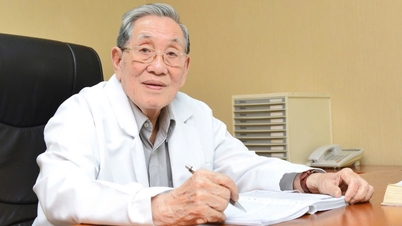








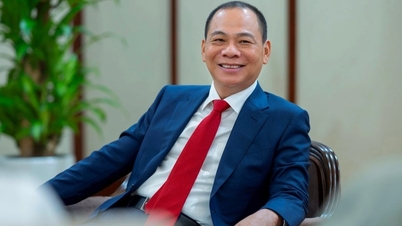

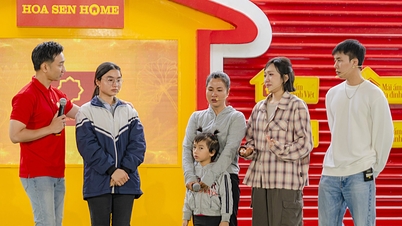
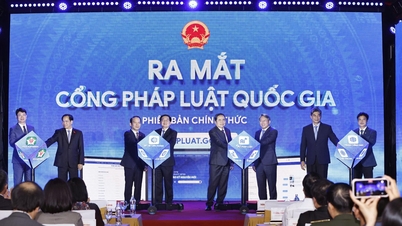














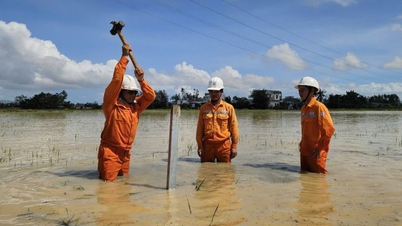








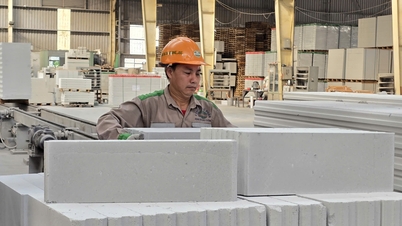



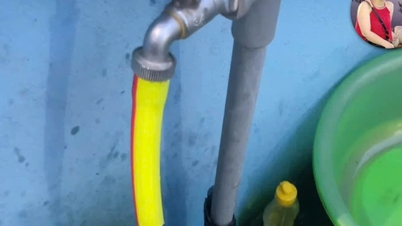

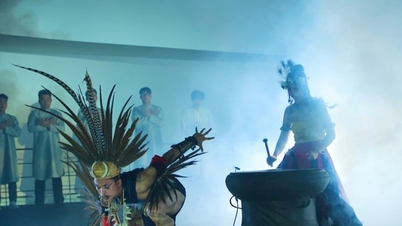

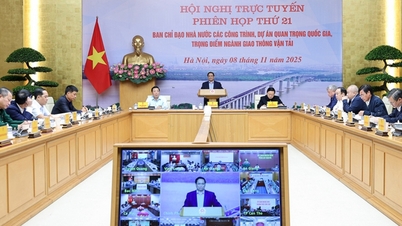




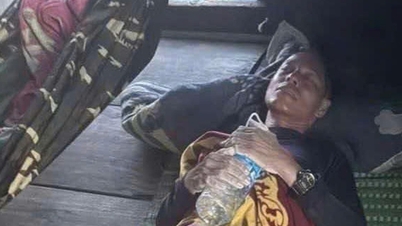











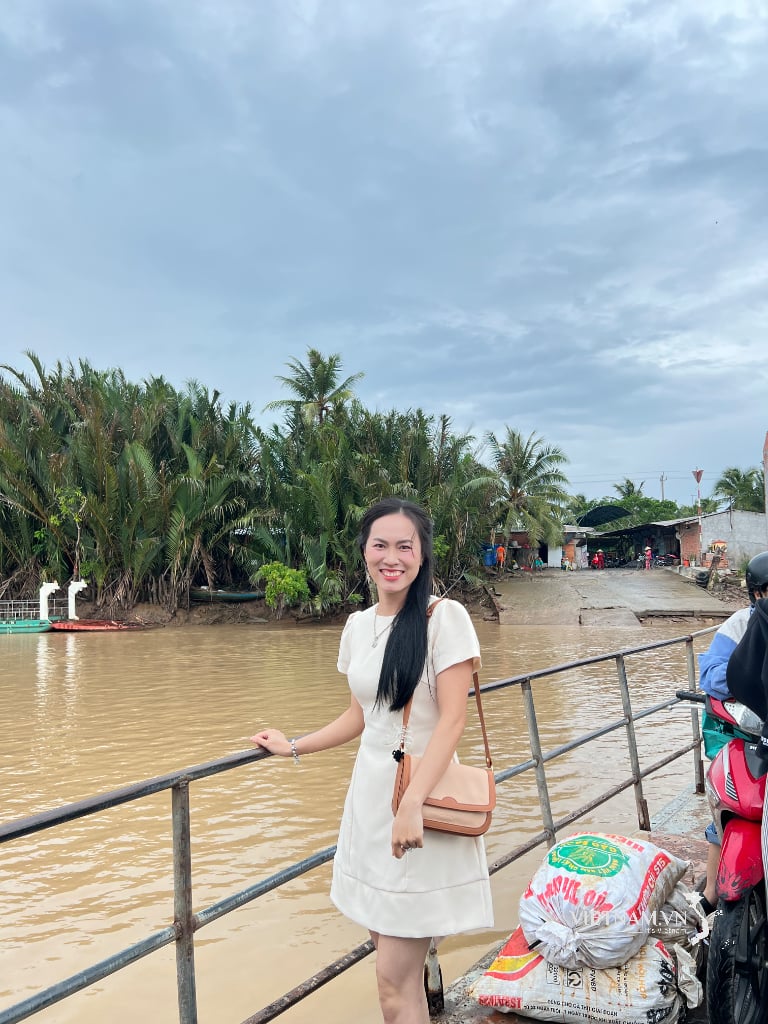


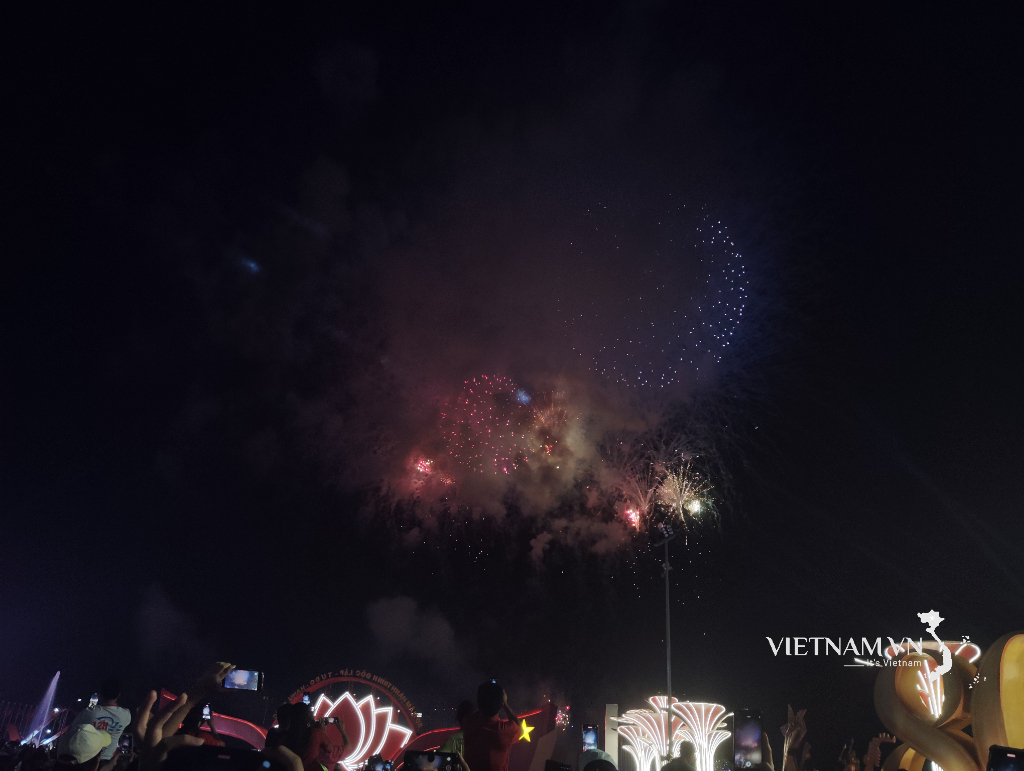
Comment (0)